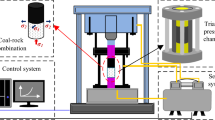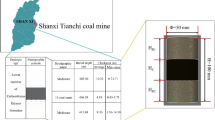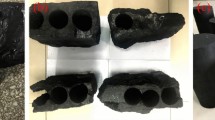Abstract
In underground coal mining, coal rib failure of longwall entries is almost certain due to the relative weakness of coal and the presence of high mining-induced stresses. To maintain the coal’s capability of sustaining large loads after failure and substantial deformation, it is crucial to understand its post-peak behavior and subsequently, its residual strength. In this study, triaxial compression tests were performed on a total of 51 coal specimens that were classified into two groups based on the existence of calcite grains. Particular emphasis was given to evaluating the residual strength of the coal specimens. It was found that the presence of calcite grains has significant effect on the brittleness of the coal. Coal specimens containing calcite grains have lower frictional strength than specimens without calcite grains. The tests demonstrated that splitting is completely suppressed when the confinement exceeds 10 % of the coal’s unconfined compressive strength. The Coulomb and Hoek–Brown failure criteria satisfactorily fit the coals’ the peak strength data over the entire confining stress range. The Hoek–Brown failure criterion satisfactorily fits the residual strength data. The parameter m for residual strength is significantly greater than that of the peak strength for both groups of coal. It was also found that as the confinement increases, the increase in residual strength is greater than the increase in peak strength.



















Similar content being viewed by others
References
Bieniawski ZT (1968a) The effect of specimen size on compressive strength of coal. Int J Rock Mech Min Sci Geomech Abstr 5:325–335. doi:10.1016/0148-9062(68)90004-1
Bieniawski ZT (1968b) In situ strength and deformation characteristics of coal. Eng Geol 2:325–340. doi:10.1016/0013-7952(68)90011-2
Buzzi O, Sieffert Y, Mendes J et al (2014) Strength of an Australian coal under low confinement. Rock Mech Rock Eng. doi:10.1007/s00603-013-0493-5
Cai M, Kaiser PK, Tasaka Y, Minami M (2007) Determination of residual strength parameters of jointed rock masses using the GSI system. Int J Rock Mech Min Sci 44:247–265. doi:10.1016/j.ijrmms.2006.07.005
Hoek E, Carranza-Torres C, Corkum B (2002) Hoek–Brown failure criterion—2002 edition. In: Proceedings of NARMS-TAC 2002 conference. Toronto, pp 267–273
Hudson JA (1989) Rock mechanics principles in engineering practice. Butterworth-Heinemann, London
ISRM (1979) Suggested methods for determining the uniaxial compressive strength and deformability of rock materials. Int J Rock Mech Min Sci Geomech Abstr 16:102. doi:10.1016/0148-9062(79)90262-6
Kaiser PK, Kim B-H (2014) Characterization of strength of intact brittle rock considering confinement-dependent failure processes. Rock Mech Rock Eng. doi:10.1007/s00603-014-0545-5
Karam G, Tabbara M (2009) Hoek–Brown strength criterion for actively confined concrete. J Mater Civ Eng 21:110–118. doi:10.1061/(ASCE)0899-1561(2009)21:3(110)
Labuz JF, Zang A (2012) Mohr–Coulomb failure criterion. In: Ulusay R (ed) The ISRM suggested methods for rock characterization, testing and monitoring: 2007–2014. Springer, Berlin, pp 227–231
Li K, Heasley K (2014) Using field measurements to quantify the post-failure behavior of coal. In: Proceeding of the 49th US rock mechanics/geomechanics symposium. San Francisco, USA, p 7
Medhurst TP, Brown ET (1998) A study of the mechanical behaviour of coal for pillar design. Int J Rock Mech Min Sci 35:1087–1105. doi:10.1016/S0148-9062(98)00168-5
Peng S (1986) Coal mine ground control, 2nd edn. Wiley, New York
Peng R, Ju Y, Wang JG et al (2014) Energy dissipation and release during coal failure under conventional triaxial compression. Rock Mech Rock Eng 48:509–526. doi:10.1007/s00603-014-0602-0
Tutluoğlu L, Öge İF, Karpuz C (2014) Relationship between pre-failure and post-failure mechanical properties of rock material of different origin. Rock Mech Rock Eng 48:121–141. doi:10.1007/s00603-014-0549-1
Walton G, Arzúa J, Alejano LR, Diederichs MS (2014) A laboratory-testing-based study on the strength, deformability, and dilatancy of carbonate rocks at low confinement. Rock Mech Rock Eng 48(3):941–958. doi:10.1007/s00603-014-0631-8
Zuo J, Xie H, Wu A, Liu J (2011) Investigation on failure mechanisms and mechanical behaviors of deep coal-rock single body and combined body. Chin J Rock Mech Eng 30:84–92
Acknowledgments
This work has been supported by the National Natural Science Foundation of China (Grant Nos. U1261211, 51304119).
Author information
Authors and Affiliations
Corresponding author
Rights and permissions
About this article
Cite this article
Gao, F., Kang, H. Experimental Study on the Residual Strength of Coal Under Low Confinement. Rock Mech Rock Eng 50, 285–296 (2017). https://doi.org/10.1007/s00603-016-1120-z
Received:
Accepted:
Published:
Issue Date:
DOI: https://doi.org/10.1007/s00603-016-1120-z




